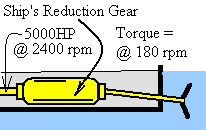| THERMO Spoken Here! ~ J. Pohl © | TOC NEXT ~ 181 |
Ship's Reduction Gear

The marine gas-turbine of a destroyer can produce 5000 horsepower at its output shaft with that shaft rotating at 25,000 revolutions per minute (rpm). The ship's turbine does not drive the ship through the water; that is what the ship's propellers do. To work well propellers turmn solwer, they turn at say 180 rpm.
Marine power engineers must design a reduction gear for each ship. The power of the turbine must be pass from the gast turbines (at the turbine rotational speed) through a reduction gear (a set of lubricated, cooled gears) to arrive at the propeller shaft with its power intact but a greatly reduced rotational speed. The gear changes the characteristics of power from "low-torque at high rpm" to "high-torque at lower rpm." The rotation rate is reduced and the torque of rotation is increased. These gear boxes are essential but inefficient. Our sketch shows the reduction gear of a gas-turbine destroyer in operation. Use the information of the sketches to answer:
a) Were the gear to operate ideally, what would be the output torque?
b) For the actual gear, calculate: i) the torque, ii) the heat rate and iii) the efficiency delivered to the prop shafts?
Problem for later: To maintain constant speed, an airline pilot sets the engines to 85% power then tips the nose up 5 degrees.
Ship's Reduction Gear

The marine turbine of a destroyer produces 5000 horsepower while rotating 25 thousand revolutions per minute (rpm). But the ship propellers work best while rotating as 180 rpm.
Were the gear to operate ideally, what would be the output torque?
Premise presently unwritted!